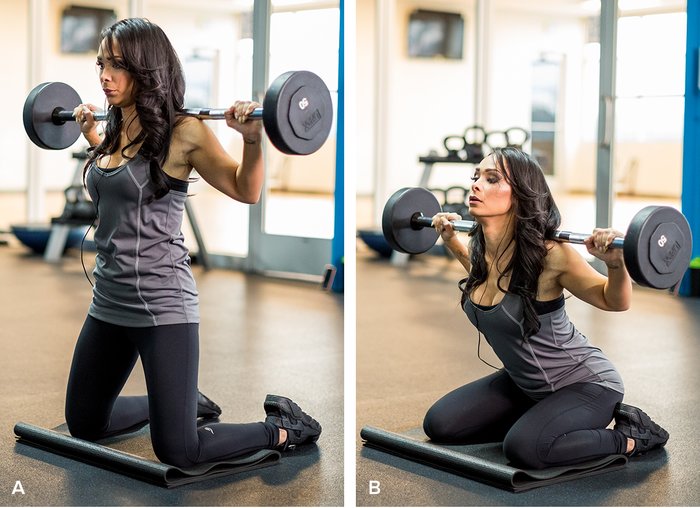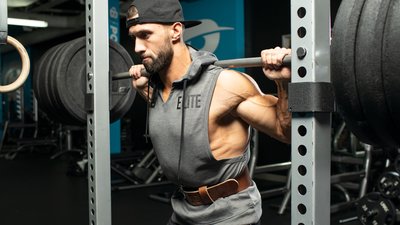Conjugate training. Developed by powerlifter Louis Simmons at his famous Westside Barbell gym in Columbus, Ohio. The name derives from the definition of "conjugate," which means to combine, join, unite. When you do conjugate training, you join together a number of different training styles to accomplish a single goal.
I've used conjugate training for decades now to increase my squat, with some very good results. If you haven't tried it, this kind of varied training might be just the thing you need to nail your next PR.
Variation 1: Hard and Soft Box Squats
The cornerstone of my squat training since 1993 has been the box squat. In keeping with the conjugate approach, I work up to a heavy single using different box levels and kinds of boxes on my maximum-effort squat workout. My traditional wooden boxes range from 10-15 inches, but I also squat to a hassock set at various levels. Using a hassock is brutal because the foam in the hassock sucks the kinetic energy from your muscles, making the concentric phase sheer hell.

Three days after my maximum-effort workout, I do a dynamic-effort squat workout. This squat day is entirely built around the box squat, but it follows a high-volume plan with either 12 doubles or 5 sets of 5 reps. On these days, I follow a maxim of the late Fred "Dr. Squat" Hatfield, a world champion powerlifter: Stay within 80 percent for your working weight on dynamic-effort day. I'll either load the bar to 80 percent of my box maximum, or add bands or chains so that the load is as close to 80 percent as possible.
If I correctly adjust medium bands (jump stretch green), then they should add a virtual 100 pounds of force to the weight at lock out. Just be sure that the weight you use on dynamic-effort day allows you to come up off the box with energy. Otherwise you're defeating the purpose of this day, which is all about lifting dynamically.
I do box squats because I think they are the safest way to squat. They cause far less wear and tear on your lower body—specifically your knees and hips—than traditional squats. Jon Cole and John Kuc, two lifting legends, believed that the best way to avoid injury in the squat was to do lots of singles and very low reps when squatting heavy. Cole and Kuc were credited back in 1972 for being co-owners of the 900-pound squat record. They both went on to compete for more than 10 years after setting that milestone—proof that you'll never reach your full potential if you are hurt and can't stand the test of time.
Variation 2: Squatting the Future
I also do squat training using the "future" method, so named because by using bands as part of the lift setup, you're able to lift a weight that you want to lift in the future without any such help.
My goal when I do future squats is to lift 120 percent of my projected max. For example, if I want to squat 500 pounds at a meet, I need to be able to squat 600 pounds suspended in mini bands. The 120-percent figure comes from Hatfield. He advised doing overloads with 120-percent of your max for a few weeks prior to a meet. He theorized that holding that much weight makes your 100-percent weight feel lighter. As any lifter knows, if you take a weight out of the rack to bench or squat and it feels light, you are a thousand times more likely to smoke that weight.

I implement the future method for squats on maximum-effort days, usually following my heaviest attempt of the day. By adding reverse bands to suspend the bar, I can overload the weight at lockout while deloading it enough so I can do the full eccentric portion with the 120-percent weight.
Variation 3: Different Squat Styles
Some of the key conjugate assistance exercises that have built my squat and deadlift are kneeling squats, Zercher squats, and power good mornings. I learned them all from Simmons.
To set up for a kneeling squat, place some padding on the floor inside a power rack and set the J-cups at a height that enables you to unrack the weight while kneeling. Once you unrack the weight, squat back until your butt is touching your calves and ankles. Then, reverse the action and squat back up to your knees.

The kneeling squat is 100 percent pure hip extension, thanks to its ability to isolate your hamstrings. These days, I like to do 5-8 reps of these squats. Back in my heyday I was doing single reps with as much as 900 pounds.
Zercher squats are the best exercise for building gut strength I've ever done. If you are built like I am—6-feet-2-inches with a 32-inch inseam—you have a long back you need to strengthen. There's no better way to strengthen the front of your back—your abs—than doing lots of Zerchers.
To begin a Zercher, place the bar in the J-cups on the rack, hold it in the crook of your arms, and position your feet in your normal squat or deadlift position. Brace yourself, then unrack the bar. Squat until your elbows scrape the inside of your knees, then reverse the action by standing erect.
An important cue is to push out your stomach as hard as you can through the entire lift. (I wear a belt when I do these because it helps me remember to do this.) Pushing out your stomach stabilizes your trunk so that your prime movers—your hips, hamstrings, quads, and glutes—do all the lifting. This stability helps you correctly lift even the biggest weights.

As a bonus, Zercher squats provide good traction to your lower back, pulling your pelvis forward and recruiting your lumbar musculature.
Power good mornings also help create a huge raw squat. Take the bar out of the rack with your regular competition bar placement. Set up as if you were going to squat, then push your knees out to the sides while at the same time pushing back your butt. As you descend, let the bar come forward approximately 4-6 inches, then return to the upright position. Repeat for 3-5 reps.
Power good mornings increase the static strength of your back by allowing the weight to travel a few more inches forward than it would with a regular squat, during which you hold your back static and let all the motion happen around your hips and knees. You'll feel this movement in your hamstrings.

Variation 4: Change the Bar
You can also implement conjugate principles on maximum-effort squat day by using different types of barbells. I've used the safety squat bar, bow bar, 14-inch cambered bar, manta ray, and Texas squat bar. You can also mix it up by squatting against bands, chains, or a combination of bands and chains.

The beauty of Simmons' conjugate training is that it makes something as routine as squat training always feel new and interesting as you quickly find your way to those "future" weights. It also goes a long way toward protecting your joints. I'm 50 years old and my hips still feel great, while some of the other hardcore powerlifters I know have had at least one hip replaced. Do I have conjugate training and/or my box-squat preference to thank for my good hips, or is it all in my genes? I don't know, but I've seen what happens with traditional training, and I'll stick with this approach.

